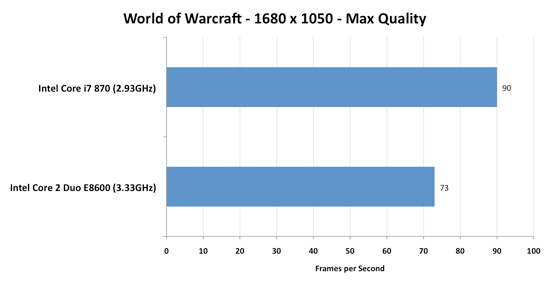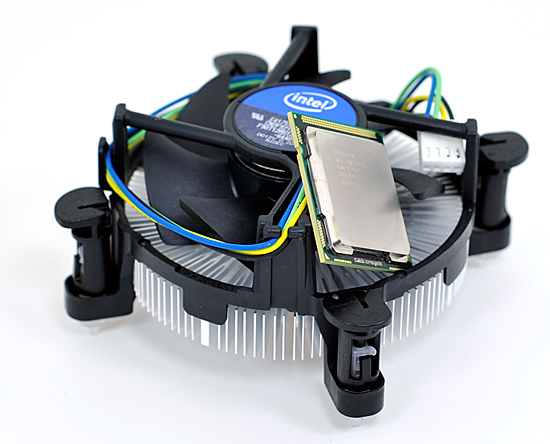Intel's Core i7 870 & i5 750, Lynnfield: Harder, Better, Faster Stronger
by Anand Lal Shimpi on September 8, 2009 12:00 AM EST- Posted in
- CPUs
Lynnfield's Turbo Mode: Up to 17% More Performance
Turbo on Bloomfield (the first Core i7) wasn't all that impressive. If you look back at our Core i7 article from last year you'll see that it's responsible for a 2 - 5% increase in performance depending on the application. All Bloomfield desktop CPUs had 130W TDPs, so each individual core had a bit more breathing room for how fast it could run. Lynnfield brings the TDP down around 27%, meaning each core gets less TDP to work with (the lower the TDP, the greater potential there is for turbo). That combined with almost a full year of improving yields on Nehalem means that Intel can be much more aggressive with Turbo on Lynnfield.
| SYSMark 2007: Overall | Dawn of War II | Sacred 2 | World of Warcraft | |
| Intel Core i7 870 Turbo Disabled | 206 | 74.3 fps | 84.8 fps | 60.6 fps |
| Intel Core i7 870 Turbo Enabled | 233 | 81.0 fps | 97.4 fps | 70.7 fps |
| % Increase from Turbo | 13.1% | 9.0% | 14.9% | 16.7% |
Turbo on Lynnfield can yield up to an extra 17% performance depending on the application. The biggest gains will be when running one or two threads as you can see from the table below:
| Max Speed | Stock | 4 Cores Active | 3 Cores Active | 2 Cores Active | 1 Core Active |
| Intel Core i7 870 | 2.93GHz | 3.20GHz | 3.20GHz | 3.46GHz | 3.60GHz |
| Intel Core i7 860 | 2.80GHz | 2.93GHz | 2.93GHz | 3.33GHz | 3.46GHz |
| Intel Core i5 750 | 2.66GHz | 2.80GHz | 2.80GHz | 3.20GHz | 3.20GHz |
If Intel had Turbo mode back when dual-cores first started shipping we would've never had the whole single vs. dual core debate. If you're running a single thread, this 774M transistor beast will turn off three of its cores and run its single active core at up to 3.6GHz. That's faster than the fastest Core 2 Duo on the market today.

WoW doesn't stress more than 2 cores, Turbo mode helps ensure the i7 870 is faster than Intel's fastest dual-core CPU
It's more than just individual application performance however, Lynnfield's turbo modes can kick in when just interacting with the OS or an application. Single threads, regardless of nature, can now execute at 3.6GHz instead of 2.93GHz. It's the epitomy of Intel's hurry up and get idle philosophy.
The ultimate goal is to always deliver the best performance regardless of how threaded (or not) the workload is. Buying more cores shouldn't get you lower clock speeds, just more flexibility. The top end Lynnfield is like buying a 3.46GHz dual-core processor that can also run well threaded code at 2.93GHz.
Take this one step further and imagine what happens when you have a CPU/GPU on the same package or better yet, on the same die. Need more GPU power? Underclock the CPU cores, need more CPU power? Turn off half the GPU cores. It's always availble, real-time-configurable processing power. That's the goal and Lynnfield is the first real step in that direction.
Speed Limits: Things That Will Keep Turbo Mode from Working
As awesome as it is, Turbo doesn't work 100% of the time, its usefulness varies on a number of factors including the instruction mix of active threads and processor cooling.
The actual instructions being executed by each core will determine the amount of current drawn and total TDP of the processor. For example, video encoding uses a lot of SSE instructions which in turn keep the SSE units busy on the chip; the front end remains idle and is clock gated, so power is saved there. The resulting power savings are translated into higher clock frequency. Intel tells us that video encoding should see the maximum improvement of two bins with all four cores active.
Floating point code stresses both the front end and back end of the pipe, here we should expect to see only a 133MHz increase from turbo mode if any at all. In short, you can't simply look at whether an app uses one, two or more threads. It's what the app does that matters.
There's also the issue of background threads running in the OS. Although your foreground app may only use a single thread, there are usually dozens (if not hundreds) of active threads on your system at any time. Just a few of those being scheduled on sleeping cores will wake them up and limit your max turbo frequency (Windows 7 is allegedly better at not doing this).
You can't really control the instruction mix of the apps you run or how well they're threaded, but this last point you can control: cooling. The sort-of trump all feature that you have to respect is Intel's thermal throttling. If the CPU ever gets too hot, it will automatically reduce its clock speed in order to avoid damaging the processor; this includes a clock speed increase due to turbo mode.

Lynnfield and its retail cooler
The retail cooler that ships with the Core i7 is tiny and while it's able to remove heat well enough to allow the chip to turbo up, we've seen instances where it doesn't turbo as well due to cooling issues. Just like we recommended in the Bloomfield days, an aftermarket cooler may suit you well.
Lynnfield: Made for Windows 7 (or vice versa)
Core Parking is a feature included in Windows 7 and enabled on any multi-socket machine or any system with Hyper Threading enabled (e.g. Pentium 4, Atom, Core i7). The feature looks at the performance penalty from migrating a thread from one core to another; if the fall looks too dangerous, Windows 7 won't jump - the thread will stay parked on that core.
What this fixes are a number of the situations where enabling Hyper Threading will reduce performance thanks to Windows moving a thread from a physical core to a logical core. This also helps multi-socket systems where moving a thread from one core to the next might mean moving it (and all of its data) from one memory controller to another one on an adjacent socket.
Core Parking can't help an application that manually assigns affinity to a core. We've still seen situations where HT reduces performance under Windows 7 for example with AutoCAD 2010 and World of Warcraft.
With support in the OS however, developers should have no reason to assign affinity in software - the OS is now smart enough to properly handle multi-socket and HT enabled machines.










343 Comments
View All Comments
moronsworld - Saturday, September 26, 2009 - link
To all you morons that don't understand economics. amd gone = intel monopoly = intel processors overpriced. Plain and simple. Take an economy class or 2, you morons. AMD is a good company, just that Intel's processors are better at the moment. God too many morons in this world that are allowed to vote. We live in a society ruled by morons.TA152H - Tuesday, September 8, 2009 - link
Actually, you don't really know what you're talking about.On-die memory controllers are nothing new. The Nexgen 586 had it in the mid-90s. Intel just knew when to add it, and when not to. That's why the Core 2 blows AMD processors away, while being significantly smaller.
AMD instruction schedulers were behind Intel's Pentium Pro from 1995 until the Phenom II came out. It still doesn't have full memory disambiguation like Intel introduced with the Core 2, but at least the memory scheduling is now on par with the Pentium Pro. I'm not sure that something they like brought up though.
64-bit processing is also old hat, and really was just an extension of the 386 protected mode anyway, with a lot of Microsoft input.
The K8 wasn't really much of an architecture, it was a K7 with a memory controller, and a couple of extra stages for better IPC, that most idiots thought was for higher clock speeds. It was a failure, and was what put AMD in the situation where they are now. It was, generally, better than the Netburst, but then, is that such a high bar to get over? The problem was, they actually believed it was a good processor until the Core 2 relieved them of that misapprehension. The reality is, Intel's mobile chips were always better than the K8, but the damn fools made us buy the Pentium 4 for the desktop. To AMD's credit, at least they never made anything horrible like that, but, really, their primary claim to fame was based more on the terrible Intel design than a great processor of their own, and the fact Intel wouldn't let us use the mobile chips for desktops.
JonnyDough - Tuesday, September 8, 2009 - link
Please work on your English before replying to me in the future. Thanks.Aenslead - Tuesday, September 8, 2009 - link
So you *must* have perfect english to reply in these forums?Gosh, never saw that in the Terms and Conditions agreement when I created my account. So that means that anybody (or a nobody, like you) have a say on what other races and people from other countries that don't speak English as their first language, that LIKE READING and giving their opinion in a FREE MOFO OPEN FORUM, must do to post here?
You and your kind are pathetic.
JonnyDough - Tuesday, September 8, 2009 - link
I didn't say anything about having perfect English. You sir, are a troll. I just wanted his reply to be coherent. This is the ENGLISH version of DailyTech, there are other language versions. His post didn't even make sense, and yours was just trolling.ginbong - Wednesday, September 9, 2009 - link
I understood what he said, maybe you need to sharpen up your analytical skills and stop being a dlckhead on this hardware analysis website.Better yet, how about taking the money you have saved for your next PC upgrade and enrolling into Grade 1 again.
dastruch - Tuesday, September 8, 2009 - link
and you don't get it too... patheticjigglywiggly - Tuesday, September 8, 2009 - link
This is a hot cpu, except I want 6 cores + HT. 32nm... quads ahh yeah. I still don't like the i5, because I don't want two sockets on one brand at the same time. It just limits options, I am only looking at i7/i9, because I bought this qx6700 in 2006 for 1000$. It was a good purchase, because q6600s were a while away and they were 500$. I got my qx6700 to 3.85ghz, now it's at 3.5ghz stable. Curse you electromigration! Also curse you economy! I don't have enough money for a 6core+6HT 1000$ cpu again.JonnyDough - Tuesday, September 8, 2009 - link
*Laughs at the moron...Go buy a Ferrari and then wreck it and sell it for parts. That's essentially a larger scale version of what you did.
Lifted - Tuesday, September 8, 2009 - link
Huh? Buying a $1000 CPU is like wrecking a Ferrari?"Laughs at the moron"